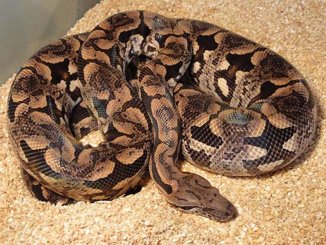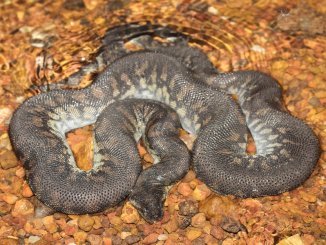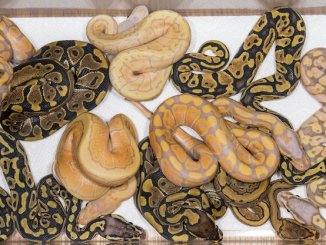The monocled cobra is a yellow, brown, gray, or blackish venomous snake that’s native to South and Southeast Asia. This snake has a monocellate, or O-shaped, pattern on its hood.
Caring for this species in captivity is challenging. The snakes need a tropical environment with consistent temperatures and humidity to survive. The monocled cobra is large and requires a big enclosure with plenty of space to move. These snakes are also dangerous, due to their venomous bites.
Monocled Cobra Overview
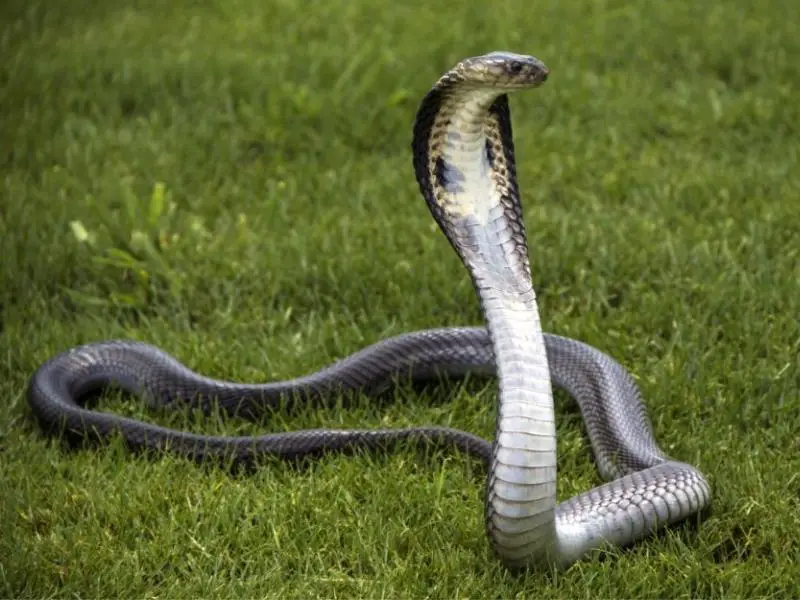
| Common name | Monocled cobra, monocellate cobra, Indian spitting cobra |
| Scientific name | Naja kaouthia |
| Natural habitat | South and Southeast Asia: Grasslands, scrublands, swamps, forests, and farmlands |
| Adult size | 48–75 inches |
| Average lifespan | 13–20 years |
| Diet | Carnivore |
| Housing | Minimum 40 gallons, 74–82°F, 50%–60% humidity |
| Experience level | Moderate |
Origin
The monocled cobra (Naja kaouthia) is commonly found in South and Southeast Asia. The snake’s natural habitats are scrublands, grasslands, paddy fields, forests, swamps, and agricultural lands, as well as human settlements.
These snakes can adapt to a range of climates and environments, but prefer habitats associated with water. The species is terrestrial and most active in the evening after the sun has set.
Appearance and Behavior
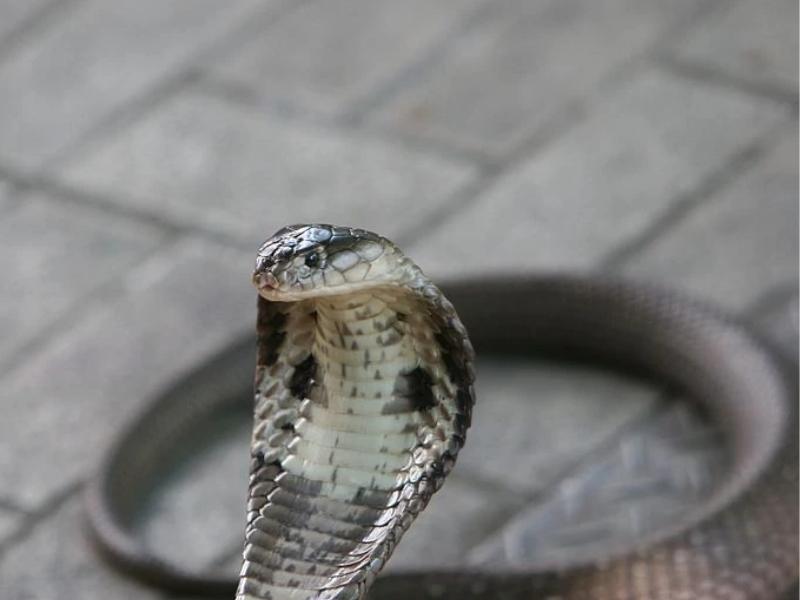
The monocled cobra is named for the circular marking on its hood, called a monocellate. The snake shouldn’t be confused with the Indian or spectacled cobra, which has a different pattern on the back of its head.
Monocled cobras are black, gray, yellow, olive, brownish, or a combination of several of these colors, and have clearly-defined or ragged cross bands. The snakes have two black spots on the undersides of their hoods, and pale, sand-colored bellies.
The cobra’s fixed anterior fangs pump venom into its prey and are moderately adapted for spitting.
Young monocled cobras have darker, bolder colors than adult and old snakes. There are no color or pattern differences between males and females.
Size and Lifespan
The average adult monocled cobra length is 48–75 inches. In the wild, the snake can grow up to 90 inches.
Monocled cobras live for between 13 and 20 years in the wild. A healthy snake housed in a clean, high-quality environment can live up to 25 years.
Temperament
The monocled cobra is a high-tempered, aggressive snake that’s known to spit and lash out when it feels threatened. When the snake is about to attack, it rises up and spreads its hood in warning, then strikes fast.
Monocled cobras are solitary, territorial creatures that should be housed alone in captivity, except when breeding. Poor or cramped tank conditions and loud noises are known to stress these snakes.
The monocled cobra shouldn’t be held because this snake has a venomous bite.
Housing Monocled Cobras
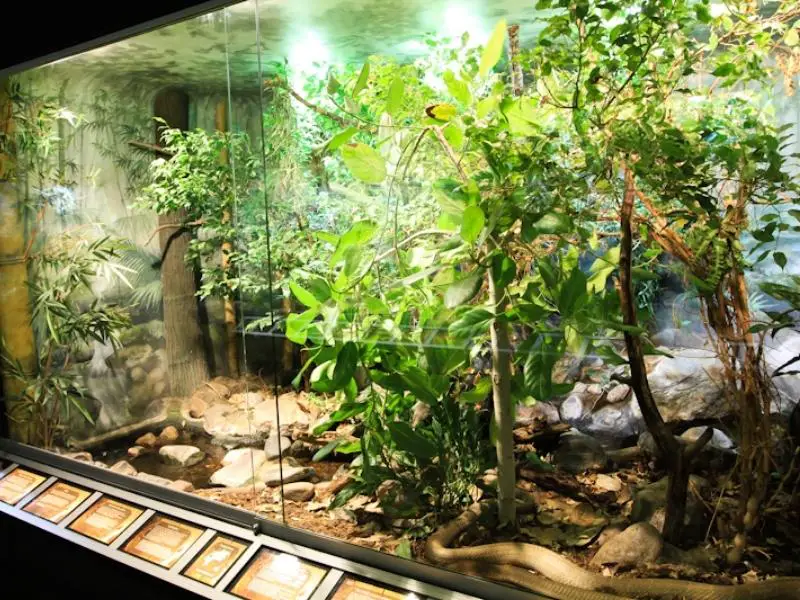
In the wild, the monocled cobra’s natural habitats are dry, grassy, or swampy regions in South and Southeast Asia.
The snakes adapt well to a variety of habitats, but their ideal grounds are well-vegetated agricultural lands or forests where rodents live (a monocled cobra’s preferred prey).
Provide a warm, humid environment for the snake in captivity to replicate its natural habitat. The best type of enclosure for a monocled cobra is a well-vented terrarium.
Enclosure size
A single monocled cobra should be housed in a terrarium of at least 40 gallons.
The snake is mostly terrestrial but enjoys climbing, so the enclosure should be at least 110 inches across to provide plenty of ground space, and 20 inches tall to accommodate climbing structures.
Lighting
UVB lighting isn’t necessary for monocled cobras as long as the captive snakes are exposed to at least eight hours of natural daylight from a nearby window.
If you choose to provide UVB lighting for your monocled cobra, keep the bulb no closer than 12 inches from the snake’s access points. Put the bulb on a 12-hour timer and turn it off at night.
Temperature and Humidity
The ideal temperature range for a monocled cobra enclosure is 74–82°F. The ambient temperature in two-thirds of the tank should be 74°F, and the temperature in the basking spot should be 82°F.
This temperature gradient allows the snake to regulate its internal body temperature by moving between hot and cool areas of the enclosure.
Use a heat lamp or a heat panel to heat the enclosure, and place a heat pad in the basking spot to increase the temperature in this section of the tank. Monitor the tank’s temperature with a thermometer.
Overnight, reduce the temperature in the tank’s cool section to 70°F to mimic the climate in the wild.
The humidity in the tank should be 50%–60%, maintained by keeping a bowl of water in the middle of the enclosure, and by misting the tank once or twice per day. Use a hygrometer to monitor for consistent humidity throughout the day.
Monocled cobras shed their skins to grow and maintain their health. Manage at least 60% humidity in the tank during shedding because lower humidity levels make shedding uncomfortable or painful for the snake.
Substrate and Decoration
Good substrates for a monocled cobra enclosure are cypress mulch or orchid bark, which absorb waste and regulate humidity levels by holding onto water. Paper towels are a good low-maintenance substrate option and can be easily replaced during a spot clean.
Avoid rough, scratchy substrates, or substrates that are difficult to clean, such as soil and sand.
Decorate the tank with plenty of vegetation and hiding spots to replicate the snake’s natural habitat. Spider plants, ficus plants, and ferns are all non-toxic, sturdy plants that grow tall enough to provide shade to the snake.
Monocled cobras are timid snakes that prefer to hide during the day. Place caves and plastic snake hides in the cool and warm sides of the enclosure.
Place several large flat rocks in the warm section of the tank to help conserve warm ambient temperatures and to give the snake a place to bask.
No special bedding is needed for the monocled cobra because the snake will sleep in a hide or on the substrate.
Cleaning
Cleaning a monocled cobra’s tank requires extra care because the snake has a venomous bite. The safest way to spot-clean the tank is to place a divider in the middle of the enclosure and clean the section that the snake isn’t in. When the snake moves to the other section of the tank, repeat the cleaning process on the uncleaned section.
To spot-clean a monocled cobra’s enclosure, start by removing and replacing soiled parts of the substrate. Wash out the water bowl and refill it with fresh, clean water. Repeat these tasks once a day, or whenever you notice dirt or feces in the tank.
A monocled cobra’s enclosure should be deep-cleaned at least once a month. To deep-clean the enclosure, carefully remove the snake from the tank using tongs or a trap box, and place the snake in a temporary tank while you empty out the main enclosure.
Discard the old substrate and wipe down the inside of the enclosure with water mixed with dish soap. Wash the decorations in hot, soapy water, then leave them to air-dry. Replace the substrate and decorations, and return the snake to the tank when all surfaces are completely dry.
Monocled Cobra Care
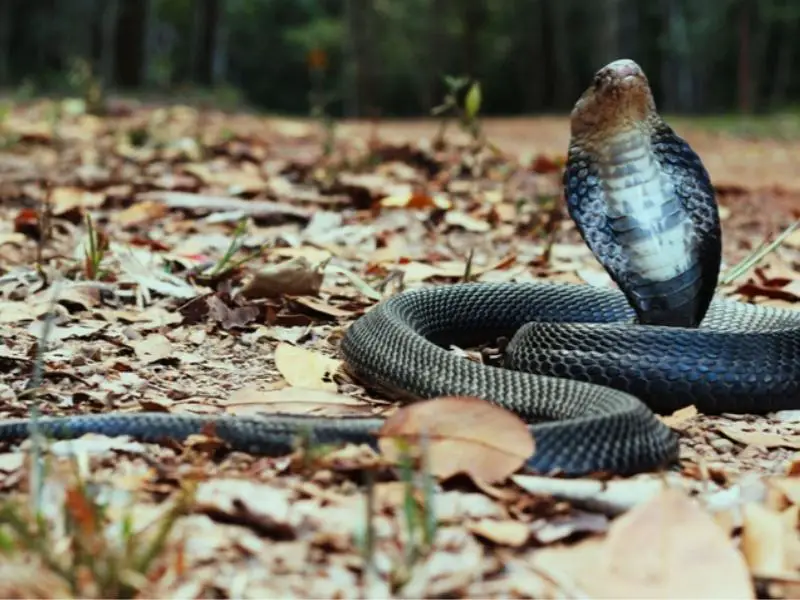
Monocled cobras are only suitable for expert snake keepers because they’re venomous, timid, and known to lash out when they’re startled. The snakes need a healthy, high-protein diet and a clean enclosure, and prefer not to be handled.
Food and Water
In the wild, monocled cobras feed on fish, small mammals, and small snakes. Feed captive monocled cobras a carnivorous diet of frozen and thawed mice and rats, and occasionally vary the diet by including chicks, quail, hamsters, or gerbils. Make sure all food provided has been humanely put down before feeding — live food can bite or scratch the snake.
Feed baby monocled cobras two pinky mice per week, and feed adult snakes one large mouse, or an equivalent-sized mammal for variation, per week. Provide fresh water in a bowl or tray that’s shallow enough for the snake to enter easily.
Handling
Monocled cobras shouldn’t be handled because they’re aggressive and poisonous. If the snake must be handled for a health check or during tank switchovers, use a snake hook, tongs, or protective gloves to prevent the snake from biting you.
Common Health Issues
There are several common health issues affecting monocled cobras:
Internal and External Parasites
Internal parasites, like worms, and external parasites, like ticks, can be transferred into a cobra enclosure from prey or from new plants and decorations. Parasites are common diseases in pet snakes and symptoms include breathing difficulties, itching, mouth infections, skin irritation, and regurgitation. Treat a monocled cobra with parasites by using over-the-counter medication recommended by your veterinarian. Empty out and sanitize the entire tank to prevent parasites from reproducing.
Respiratory Infections
Respiratory infections are caused by bacteria, viruses, and fungi, which are typically present in overly humid or dirty enclosures. Symptoms of respiratory infections in snakes include nasal discharge, mucus, lethargy, wheezing, and loss of appetite. Speak to your veterinarian for medications to treat this health concern. Prevent further respiratory infections by monitoring the enclosure’s humidity and ventilating the tank if necessary.
Breeding
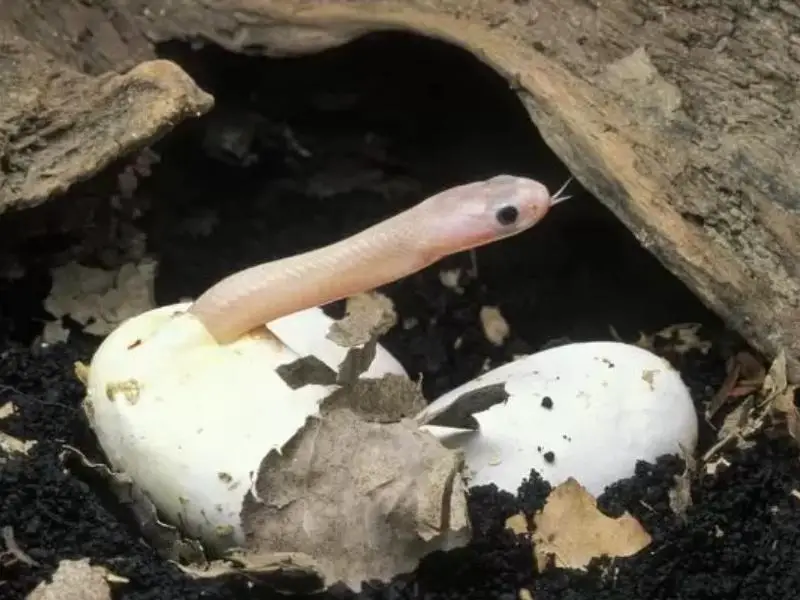
Due to the venomous nature of monocled cobras, breeding the snakes is only advised for professionals. To breed a pair of monocled cobras, follow these steps:
- Choose a healthy male and female to breed. Prepare a separate 80-gallon breeding enclosure, using the same decorations, temperature, and humidity as the home tank. Place a nest box in the tank containing moist substrate, like sphagnum moss, where the female can lay her eggs
- Place the male in the breeding tank (include the female later)
- Keep the male in the breeding tank for one month and gradually decrease the temperature in the tank’s cold section to 68°F. Feed both snakes a protein-rich diet in their separate tanks
- Introduce the female to the breeding tank after one month. The male will refuse to eat in preparation to breed, but the female will continue to eat. On average, it takes several days for the pair to breed after being introduced. The female will lay between 12 and 30 eggs in the nest box about 40 days after breeding with the male. Place the nest box inside an incubator, ensuring the temperature is about 84°F, and humidity is 70%
- The eggs will hatch after between 50 and 60 days. Newborn monocled cobras are independent at birth, so the parents can be moved back to their home enclosures as soon as the babies are born
- Feed each baby cobra two pinkie mice per week until the snakes are six months old, then move the snakes to their own separate enclosures and feed the snakes one full-sized mouse or rat each per week
Choosing and Buying a Monocled Cobra
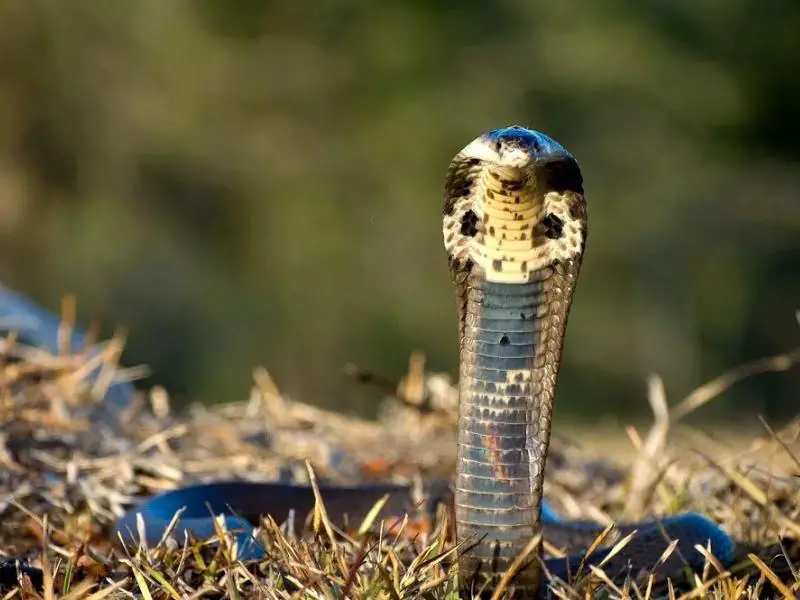
The average cost of a monocled cobra is $250. The snakes aren’t commonly available in pet stores, but they’re sold by some breeders.
Some states have exotic animal laws because of the risk the snakes pose to the general public, so you should check your state’s laws before you buy a monocled cobra. Getting liability insurance for venomous snakes is highly recommended when buying a monocled cobra.
To check that a snake is healthy before you buy it, ensure the snake has clear eyes and smooth, shiny scales. Avoid snakes with cloudy eyes, sores, or black dots that resemble mites. Ask the breeder for permission to watch the snake feed, and check that the snake has a healthy appetite. Only buy from a reputable, experienced, knowledgeable breeder.

